Sold Ceramics
Sold Japanese Imari 1690-1800
Tableware and other Porcelain with Western Shapes
Page 1

Sold Ceramics - Sold Japanese Imari 1690-1800 - Tableware and other Porcelain with Western Shapes - Page 1
Object 2011850
Bottle
Japan
c.1700
Height with cover 260 mm (10.23 inch), height without cover 216 mm (8.50 inch), dimensions base 85 mm (3.35 inch) x 85 mm (3.35 inch), dimensions shoulder 96 mm (3.77 inch) x 100 mm (3.93 inch), diameter of mouthrim 25 mm (0.98 inch), weight with cover 837 grams (29.52 ounce (oz.)), weight cover 27 grams (0.95 ounce (oz.))
Square bottle on unglazed base, flaring slightly to the shallow domed shoulder. The shoulder slopes up to smaller square with a short central narrowing neck which flares at the base and top. An unglazed cylindrical mouth with a glazed rim. The original cover is missing and replaced by a gold plated silver cap. Imari, decorated in iron-red, gold, a pink gold-wash and oxidised silver. The sides with two panels a square lower panel with moulded basket work in low relief and a rectangular upper panel with the moulded chrysanthemum flower heads in low relief surrounded by scattered flowerheads. The panels are surrounded by black floral sprays (oxidised silver). On the shoulder two parts (six and nine petals) of a stylized chrysanthemum crest, (kiku no mon), drawn with double iron- red outline and filled with gold. The petals are decorated in iron-red, gold and a pink gold-wash, alternately filled with a swastika diaper pattern and a floral scroll. On the neck a lappet pattern border. On the base a rectangular paper label that reads: 'Nico a_18'
The shape of this bottle derived from a Dutch glass ginn bottle and is also found in Chinese export porcelain of the early 17th century. Unlike earthenware, Japanese and Chinese porcelain was not porous, and such bottles had a number of uses in Europe such as for spirits and oils.The bottle could have been used in Japan as a toguri, a sake bottle. The low relief basket work of the lower panels could very well be an imitation of a braided wicker casing that was bound / tied around the original Dutch glass bottle which served as the model, to protect it from breaking. (Ayers, Impey & Mallet 1990, p.108 cat. 56), (Howard 1994, p.204), (Jörg 2003/1, p.60)
For a similarly shaped bottle with basket work in low relief in the lower panels, please see:
For similarly decorated objects with moulded flower heads in low relief, please see:
- Fine & Curious: Japanese Export Porcelain in Dutch Collections, (C.J.A. Jörg, Hotei publishing, Amsterdam, 2003), p.100, cat. 99 & 100
-
Sold Ceramics - Sold Japanese Imari 1690-1800 - Other wares - Page 1 - Object 2011605.
-
Sold Ceramics - Sold Japanese Imari 1690-1800 - 'Gold' Imari - Page 2 - Object 2010600.
Condition: Two short hairlines and a chip to the mouthrim. A Y-shaped hairline to one side.
References:
Ayers, Impey & Mallet 1990, cat. 56
Jörg 2003/1, p.60 & cat. 99 & 100
Price: Sold.
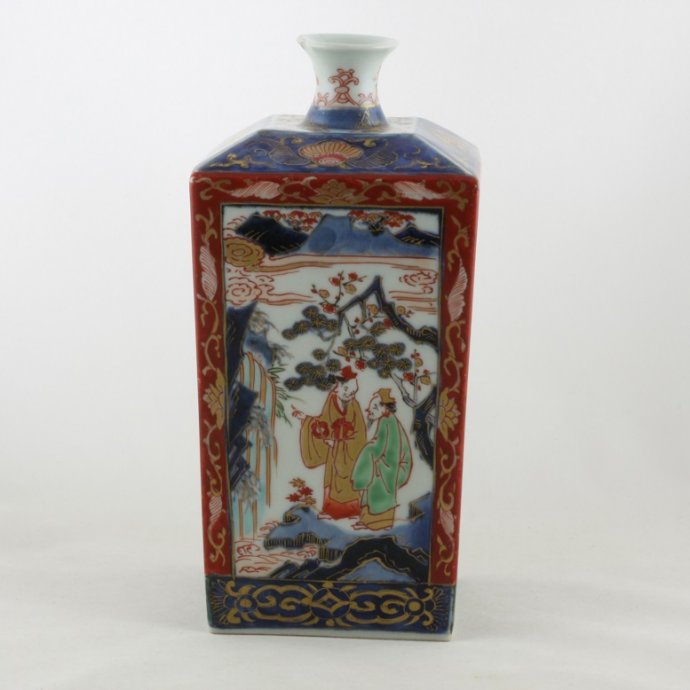
Sold Ceramics - Sold Japanese Imari 1690-1800 - Tableware and other Porcelain with Western Shapes - Page 1
Object 2011856
Bottle
Japan
1700-1720
Height 212 mm (8.35 inch), dimensions base 85 mm (3.35 inch) x 85 mm (3.35 inch), dimensions shoulder 97 mm (3.82 inch) x 98 mm (3.86 inch), diameter of mouthrim 35 mm (1.38 inch)
Square bottle on unglazed base, flaring slightly to the shallow domed shoulder. The shoulder slopes up to smaller square with a short central narrowing neck which flares at the base and top. Restorations in gold lacquer on the mouthrim. Imari, decorated in underglaze blue, iron-red, green and black enamel and gold. On the sides scholars standing in a mountainous landscape reserved on an iron-red ground with floral scrolls. Round the foot and on the shoulder floral scrolls in gold on an underglaze blue ground. On the base of the neck floral scrolls and round its foot a pointed leaves pattern border in gold on an underglaze blue ground. Around the neck floral scrolls.
The shape of this bottle derived from a Dutch glass ginn bottle and is also found in Chinese export porcelain of the early 17th century. Unlike earthenware, Japanese and Chinese porcelain was not porous, and such bottles had a number of uses in Europe such as for spirits and oils. The bottle could have been used in Japan as a toguri, a sake bottle. (Ayers, Impey & Mallet 1990, p.108 cat. 56, Howard 1994, p.204), (Jörg 2003/1, p.60)
For identically shaped and similarly decorated bottles, please see:
- Mistrovská dĩla Japonského porcelánu / Masterpieces of Japanese Porcelain, (F. Suchomel, Prague 1997), p.126, cat. 151 & p.134, cat. 172.
- Complete Catalogue of the Shibata Collection, (The Kyushu Ceramic Museum, Kyushu 2003), p.348, cat. 2702 & p.352, cat. 2754.
For a similarly shaped and decorated pair of bottles, please see:
Interestingly, this bottle has an old original Japanese gold lacquer restoration which could indicate it was used as such in Japan. Kintsugi (金継ぎ) (Japanese: golden joinery) or Kintsukuroi (金繕い) (Japanese: golden repair) is the Japanese art of repairing broken pottery with lacquer dusted or mixed with powdered gold, silver, or platinum, a method similar to the maki-e technique. As a philosophy it treats breakage and repair as part of the history of an object, rather than something to disguise. (source: wikipedia.org/wiki/Kintsugi)
For some examples of objects with gold lacquer restorations, please see:
- Ko-Imari from the collection of Oliver Impey, (Barry Davies Oriental Art, London, 1997), pp.142-143, cat. 80.
- Complete Catalogue of the Shibata Collection, (The Kyushu Ceramic Museum, Kyushu 2003), p.407, cat. 3198.
- Fine & Curious, Japanese export porcelain in Dutch Collections, (C.J.A. Jörg, Hotei Publishing, Amsterdam, 2003), p.56, cat. 39.
-
Chine de commande - Western Subjects 1680-1800 - Various Subjects - Various - Object 2011588.
Condition: A short hairline and restorations in gold lacquer to the mouthrim.
References:
Ayers, Impey & Mallet 1990, cat. 56 & 222
Kyushu 2003, cat. 2702, 2754 & 3198
Jörg 2003/1, p.60 & cat. 39, 99 & 100
Price: Sold.

Sold Ceramics - Sold Japanese Imari 1690-1800 - Tableware and other Porcelain with Western Shapes - Page 1
Object 2012140
Chamber-pot
Japan
c.1700
Height 60 mm (2.36 inch), diameter of mouthrim 78 mm (3.07 inch), diameter of footring 41 mm (1.61 inch), weight 119 grams (4.20 ounce (oz.))
Exhibited: 'Japanes porselein uit Nederlandse collecties', (Japanese export porcelain in Dutch collections) held at the Groninger Museum from 4 June - 10 September 2000.
Small chamber-pot on footring, spreading rim, curved handle with thumb-rest. Decorated in red, green, black and aubergine enamels and gold with two groups of flowering gardenias growing from rockwork. Round the foot two red lines, on the inside of the rim a karakusa scroll partly in red, partly outlined in red, and divided by single flowers. On the handle a floret between scrolls.
From June 4th to September 10th 2000 the exhibition 'Japanes porselein uit Nederlandse collecties', (Japanese export porcelain in Dutch collections) held at the Groninger Museum. The exhibition formed part of the many activities in The Netherlands in that year celebrating the 400th anniversary of Dutch-Japanese relations. This chamber-pot was one the objects on display at the exhibition and was described by Jörg in his book Fine & Curious on page165, catalogue number 191.
For an another indentically shaped, sized and decorated chamber-pot for sale, please see:
Jörg also shows a similarly sized and decorated cuspidor. (Jörg 2003/1, p.166, cat. 193)
For a slightly larger chamber-pot decorated in underglaze blue, please see:
The use of this small chamber-pot is unknown. It is too large to be placed in a doll's house. In general, miniatures were included in groups of decorative porcelain placed on shelves, brackets and consoles in the Dutch interior, or in the porcelain rooms of the grand houses such as those still in Pommersfelden and Charlottenburg, Germany. Similar miniature objects were also made of silver and glass, and the pieces of Japanese (and Chinese) porcelain fit into the general trend. (Jörg 2003/1, p.190)
Condition: Firing flaws to the rim and the footring, a popped bubble of glaze, a glaze rough spot and a frit and chip to rim.
References:
Jörg 2003/1, p.166, p.190, cat.191 & 193
Price: Sold.

Sold Ceramics - Sold Japanese Imari 1690-1800 - Tableware and other Porcelain with Western Shapes - Page 1
Object 2012192
Miniature mustard pot
Japan
c.1700
Height 59 mm (2.32 inch), diameter mouthrim 19 mm (0.75 inch), diameter foot 27 mm (1.06 inch), weight with cover 68 grams (2.40 ounce (oz.)), weight cover 11 grams (0.39 ounce (oz.))
Miniature mustard pot of baluster shape moulded as an opening lotus flower, on a ribbed conical stem. Curved C-shaped handle. Fitted with a contemporary unmarked Dutch silver cover identically shaped and sized as the original cover which is missing. Imari, decorated in overglaze iron-red, green, aubergine enamels and gold with two ranks of moulded lotus petals in low relief, filled with carnation and prunus sprays. Round the mouthrim a scrollwork border and on the splayed foot a zig-zag lines pattern border. Round the foot a petal-pattern border and on the handle a floret between scrolls.
Porcelain miniatures were popular in The Netherlands, where they were used to furnish doll's houses, which were not children's playthings but professionally furnished replicas of townhouses. Poppegoet is mentioned in the VOC orders of 1662, this was probably just a name for small objects made of porcelain and not specifically for doll's houses.
In general, miniatures were included in groups of decorative porcelain placed on shelves, brackets and consoles in the Dutch interior, or in the porcelain rooms of the grand houses, such as those still in Pommersfelden and Charlottenburg. Germany. Similar miniature objects were also made of silver and glass, and the pieces of Japanese (and Chinese) porcelain fit into the general trend. (Jörg 2003/1, p.190)
An identically shaped, sized and decorated miniature mustard pot with its original cover, currently on display in the Groninger Museum at the exhibition. The world at home. Asian Porcelain and Dutch pottery, the exibition is being held until March 10, 2019.
For identically shaped, sized and decorated miniature mustard pots, please see;
- Porcelain for Palaces. The Fashion for Japan in Europe 1650-1750, (J. Ayers, O. Impey & J.V.G. Mallet, Oriental Ceramic Society & The British Museum, London 1990), p.206, cat. 202.
- The Voyage of Old-Imari Porcelains: Exhibition Catalogue of the Kyushu Ceramic Museum, Arita 2000, p.94, cat.180.
- Japanese Export Porcelain. Catalogue of the Collection of the Ashmolean Museum, Oxford, (O. Impey, Hotei Publishing, Amsterdam, 2002), p.193, cat. 308.
- Fine & Curious, Japanese export porcelain in Dutch Collections, (C.J.A. Jörg, Hotei Publishing, Amsterdam, 2003), p.190, cat. 190.
For identically shaped and decorated 'regular sized' mustard pots, please see;
- Porcelain for Palaces. The Fashion for Japan in Europe 1650-1750, (J. Ayers, O. Impey & J.V.G. Mallet, Oriental Ceramic Society & The British Museum, London 1990), p.206, cat. 202.
- The Voyage of Old-Imari Porcelains: Exhibition Catalogue of the Kyushu Ceramic Museum, Arita 2000, p.94, cat.180.
- Japanese Export Porcelain. Catalogue of the Collection of the Ashmolean Museum, Oxford, (O. Impey, Hotei Publishing, Amsterdam, 2002), p.193, cat. 308.
- Fine & Curious, Japanese export porcelain in Dutch Collections, (C.J.A. Jörg, Hotei Publishing, Amsterdam, 2003), p.190, cat. 190.
Sold object 2011760 (not included in this sale) a similar decorated 'normal' sized Japanese Imari salt.
Condition: Some firing flaws.
References:
Ayers, Impey & Mallet 1990, cat. 202
Price: Sold.

Sold Ceramics - Sold Japanese Imari 1690-1800 - Tableware and other Porcelain with Western Shapes - Page 1
Object 2011760
Salt
Japan
c.1700
Height 68 mm (2.68 inch), diameter concave scale 45 mm (1.77 inch), diameter foot 90 mm (3.54 inch), weight 152 grams (5.36 ounce (oz.))
Salt, the high, domed open body on three small ball feet. The neck widening into a broad rim tapering to the slightly concave top. Imari, decorated in overglaze iron-red, green, aubergine enamels and gold. The lower part with moulded panels shaped as lotus petals in low relief, filled with carnation and prunus sprays. On the neck a zig-zag lines pattern border and three flowering prunus sprays. The shoulder with flowerheads alternating with foliate scrolls. On top, inside the scale, a flowering carnation spray. (Jörg 2003/1, p.164)
Jörg compares a pair of similarly shaped and Imari decorated Japanese salts with a underglaze blue Chinese Kangxi salt. These Japanese salts are a close copy of the underglaze blue Chinese salt similarly shaped and moulded with lotus-leaf panels and dating to c.1700. Such Chinese Kangxi salts were based, in turn on Dutch ceramic models. Because of the decoration, which does not occur on Dutch salts, it can be stated that the Japanese piece was not copied directly from a Dutch model but from a Chinese example and consequently dates to c.1700. So its shape was copied from a Dutch ceramic original. In turn it was used as a model after which the Japanese salts were made. (Jörg 2003/1, p.164)
A comparison between the Japanese Imari salt (2011760) and an earlier sold Chinese Kangxi salt (2011441). In shape and decoration this Chinese salt is even closer to the Japanese salt than the Chinese Kangxi example Jörg uses in his comparison.
In both moulding and colouring this salt was inspired by, or ancestral to Chinese famille verte wares of the Kangxi period. It may be assumed to precede composite condiment sets in the more developed 'Imari style'. which were in Europe before 1721. Japanese salt-cellars were, (according to T. Volker), first exported in 1669. (Ayers, Impey & Mallet 1990, p.206)
The material and the Chinese style decoration made this salt an exotic object that was prominently placed on a richly laid table. At this time salts were ordered separately, and only much later as part of a dinner service. With many Christian connotations, salt was an important seasoning at dinner before the 19th century and salts were larger and more elaborate than they are today. (Jörg 2011/2, p.148)
For identically shaped and decorated salts, please see;
- Eastern Ceramics and other works of art from the collection of Gerald Reitlinger, (Ashmolean Museum, Oxford 1981), p.83, cat 221.
- Porcelain for Palaces. The Fashion for Japan in Europe 1650-1750, (J. Ayers, O. Impey & J.V.G. Mallet, Oriental Ceramic Society & The British Museum, London 1990), p.206, cat. 202.
- Mistrovská dĩla Japonského porcelánu / Masterpieces of Japanese Porcelain, (F. Suchomel, Prague 1997), p.104, cat. 91.
- The Voyage of Old-Imari Porcelains: Exhibition Catalogue of the Kyushu Ceramic Museum, Arita 2000, p.68, cat.118.
- Japanese Export Porcelain. Catalogue of the Collection of the Ashmolean Museum, Oxford, (O. Impey, Hotei Publishing, Amsterdam, 2002), p.193, cat. 308.
- Fine & Curious, Japanese export porcelain in Dutch Collections, (C.J.A. Jörg, Hotei Publishing, Amsterdam, 2003), p.164, cat. 187.
Condition: All three feet restored.
References:
Ayers, Impey & Mallet 1990, cat. 202
Price: Sold.
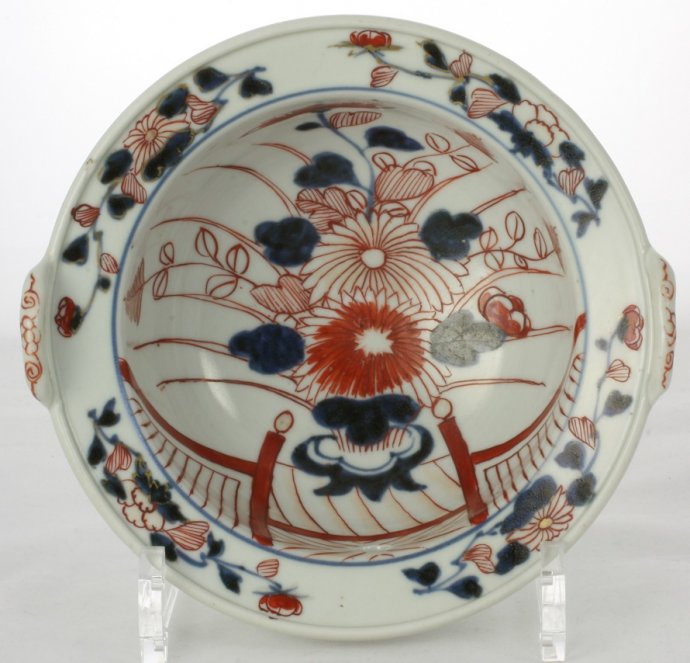
Sold Ceramics - Sold Japanese Imari 1690-1800 - Tableware and other Porcelain with Western Shapes - Page 1
Object 2010505
Milk bowl
Japan
1700-1730
Height 70 mm (2.76 inch), diameter of rim 164 mm (6.46 inch), diameter of footring 62 mm (2.44 inch)
Milk bowl with near vertical sides pinched spout at the top, short flat rim, upturned edge with two arched handles. On the base a firing ring, and three conical feet. Imari, decorated in underglaze blue, iron-red and gold On the bottom a jardinière filled with flowers including chrysanthemum and peony on a terrace. On the rim four flower sprays including chrysanthemum and peony. The reverse is undecorated. Marked on the base with a, most likely, shop or painters mark in underglaze blue.
Such bowls, imitating a Dutch earthenware model, were used to pour the cream off the milk. They seem to be quite rare. (Jörg 2003/1, p.176)
For a similarly shaped and decorated milk bowl, please see:
- In the wake of the Liefde, Cultural relations between the Netherlands and Japan, since 1600, exhibition catalogue, (Museum for Ethnology, Rotterdam, 1986), p.91, cat 72.
- Fine & Curious. Japanese Export Porcelain in Dutch Collections, (C.J.A. Jörg, Hotei Publishing, Amsterdam, 2003), p. 176, Fig. 213 & 213a.
For an identically shaped and decorated only in underglaze blue milk bowl, please see:
- Japans porselein met blauwe decoraties uit de tweede helft van de zeventiende en de eerste helft van de achttiende eeuw, (D.F. Lunsingh Scheurleer, in, Mededelingenblad Nederlandse Vereniging van Vrienden van de Ceramiek, 64/65, 1971), p.113, cat. 187.
- Fine & Curious. Japanese Export Porcelain in Dutch Collections, (C.J.A. Jörg, Hotei Publishing, Amsterdam, 2003), p. 176, Fig. 212.
Condition: A tiny glaze frit to the rim.
References:
Lunsingh Scheurleer 1971, cat. 187
Jörg 2003/1, cat..212, 213 & 213a
Price: Sold.

Sold Ceramics - Sold Japanese Imari 1690-1800 - Tableware and other Porcelain with Western Shapes - Page 1
Object 201037
Mustard pot
Japan
1700-1730
Height with cover 124 mm (4.84 inch), height without cover 104 mm (4.09 inch), height cover 32 mm (1.26 inch), diameter mouthrim mustard pot 40 mm (1.57 inch), diameter of footring 51 mm (2.01 inch), diameter mouthrim cover 14 mm (0.55 inch), weight including cover 269 grams (9.49 ounce (oz.)), weight cover 31 grams (1.09 ounce (oz.))
Mustard pot of baluster shape with a spreading foot and a partially glazed, sunked in, base. Curved C-shaped handle. Wide mouth and a shallow domed cover with a central open ring knob for a wooden spoon. Imari, decorated in underglaze blue, overglaze iron-red and gold. On the foot a decoration of chrysanthemum and peony branches, around the waist a lotus leaves border and on the body two panels reserved on a ground of chrysanthemum and peony flowers scrolls, one panel is decorated with a flowering chrysanthemum plant the other with a flowering peony plant. On the shoulder scrolls of flowering chrysanthemum. The open cover is similar decorated with two panels reserved on a ground of chrysanthemum and peony flowers scrolls, one panel is decorated with chrysanthemum the other with peony flowers,
Mustard was extremely popular in The Netherlands where it was used to improve the taste of food and was made locally. It was not well homogenised yet, and had to be stirred before use. Small (wooden) spoons came with the pots, which consequently have either a round opening in the cover (as here) or an opening in the mouthrim. (Jörg 2003/1, p.162)
For an identically shaped mustard pot, please see:
Condition: Perfect.
References:
Lunsingh Scheurleer 1977, cat. 181
Price: Sold.

Sold Ceramics - Sold Japanese Imari 1690-1800 - Tableware and other Porcelain with Western Shapes - Page 1
Object 2011845
Cuspidor
Japan
1700-1730
Height 38 mm (1.49 inch), diameter of rim 197 mm (7.76 inch), diameter of footring 135 mm (5.31 inch), weight 431 grams (15.20 ounce (oz.))
Cuspidor on footring. Globular body with curved handle. Very short narrow neck, the upper part shaped as a bowl with wide flaring sides. Imari, decorated in underglaze blue, iron-red and gold. On the body two flower sprays, inside the upper part a gnarled blossoming cherry branch. The reverse is undecorated. (Jörg 2003/1, p.167, cat. 195)
Cuspidors were indispensable in the interior especially in the East Indies where both tobacco and betel nuts were chewed. Volker mentions Japanese porcelain and copper cuspidors in the lodges of the merchants on Deshima for 1701 and 1702. Dutch metal or earthenware cuspidors will have served as models, although the same shape has been known in Chinese ceramics since the Tang period, serving as a vase for a lotus flower. Interestingly, the VOC documents make no mention of Company shipments or orders for cuspidors, and they must therefore have been shipped privately. (Volker 1959, pp.28-29)
For a identically shaped sized and decorated Cuspidors, please see;
- Imari. Porcelain for European Palaces from the Freda and Ralph Lupin Collection. (L. Rotondo-McCord & P.J. Bufton, New Orleans Museum of Art, New Orleans 1997), p.41, cat. 23.
- Fine & Curious. Japanese Export Porcelain in Dutch Collections, (C.J.A. Jörg, Hotei Publishing, Amsterdam, 2003), p.167, cat. 195.
Condition: A tiny firing flaw to the rim.
References:
Price: Sold.

Sold Ceramics - Sold Japanese Imari 1690-1800 - Tableware and other Porcelain with Western Shapes - Page 1
Object 2010660A
Ewer
Japan
1700-1730
Height 105 mm (4.13 inch), diameter of belly 81 mm (3.19 inch), diameter of mouthrim 32 mm (1.26 inch), diameter of footring 44 mm (1.73 inch), weight 184 grams (6.49 ounce (oz.))
Oviform ewer on footring, wide neck with pinched spout. Curved pierced handle placed at an angle to the spout. Imari,decorated in underglaze blue, iron-red and gold with flowering chrysanthemum and peony plants, On the handle a floret between scrolls.
The piercing on the handles of this and similar shapes is original, and was intended for the silver or other metal mount that would customarily have been added in Europe.
Condition: Two firing flaws.
Price: Sold.
More pictures of object 2010470, another identically shaped, sized and decorated, sold ewer >>

Sold Ceramics - Sold Japanese Imari 1690-1800 - Tableware and other Porcelain with Western Shapes - Page 1
Object 2011664
Miniature chamber-pot
Japan
1700-1730
Height 31 mm (1.22 inch), diameter of mouthrim 46 mm (1.81 inch), diameter of footring 20 mm (0.79 inch), weight 23 grams (0.81 ounce (oz.))
Miniature chamber-pot on footring, spreading rim, curved handle with thumb-rest. Imari, decorated in underglaze blue, iron-red and gold with grasses and a chrysanthemum flower spray. On the handle and rim florests between scrolls.
The use of this miniature chamber-pot is unknown. It is too large to be placed in a doll's house. In general, miniatures were included in groups of decorative porcelain placed on shelves, brackets and consoles in the Dutch interior, or in the porcelain rooms of the grand houses such as those still in Pommersfelden and Charlottenburg, Germany. Similar miniature objects were also made of silver and glass, and the pieces of Japanese (and Chinese) porcelain fit into the general trend. (Jörg 2003/1, p.190)
Condition: Restored.
Reference:
Price: Sold.
Shaving bowls
Shaving bowls were used by barbers and were indispensable in the Dutch household too. They were made of earthenware, pewter, copper and even silver. Beside their function as a shaving utensil, they had an alternative use, namely to let blood from a vein in the arm during blood-letting. This was a medical procedure thought to drain bad blood from the system, which was also performed by the barber/surgeon. In the seventeenth century, regulations were put in place in England to govern what barbers were permitted to do. Thus they became confined to bloodletting and treating external diseases. In Prussia the barbers' and the surgeons' guild joined in 1779, and it was said of great Prussian surgeons that they had risen "up from the barber's bowl”. Both purposes explain the semi-circular saving. The two holes in the rim are for a cord or string. A shaving basin with the actual silk string still attached was excavated in Amsterdam. The string was used to suspend it from the client's neck to catch lather and water during shaving, or to hang the bowl on the wall thus implying that owners also appreciated the bowl for its decorative value as well as its function. Shaving bowls can be seen hanging on the wall as such in some dollhouses.
Cornelis Troost, Arlequin toovenaar en barbier, 1738, Mauritshuis, The Hague, Netherlands, inv. nr. 184. In spite of the satirical intent, the painting reflects actual usage.
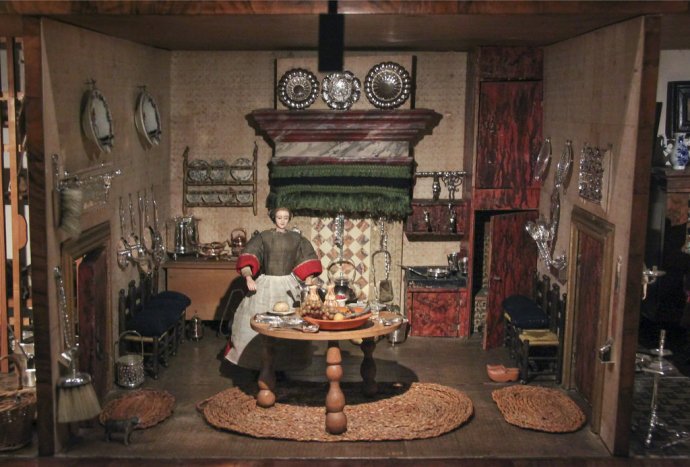
The doll’s house of Petronella Dunois (1650-1695), c. 1676, Rijksmuseum, Amsterdam, the Netherlands, inv.nr. BK-14656. Two shaving dishes are suspended on the left wall.

Sold Ceramics - Sold Japanese Imari 1690-1800 - Tableware and other Porcelain with Western Shapes - Page 1
Object 2012207
Shaving bowl
Japan
1700-1730
Height 74 mm (2.91 inch), diameter of rim 274 mm (10.79 inch), diameter of footring 104 mm (4.09 inch), weight 771 grams (27.20 ounce (oz.))
Shaving bowl on high footring. Flat rim with a saved semi-circular section and two small holes opposite the cut-out section. Decorated in underglaze blue and overglaze iron-red, black, green, grey and yellow enamel with a central design of intertwined leaves from the branches of two trees.In the middle in the glaze, a large ring was, supposed to be, left unglazed but is glazed. On the rim a three reserves each outlined with leafy scrolls on an iron-red ground and filled with three reserves on an underglaze blue ground with leafy scrolls in gold. On the reverse two wide spread prunus sprays.
Shaving bowls were used by barbers and were indispensable in the Dutch household too. They were made of earthenware, pewter, copper and even silver. They had an alternative use namely, to let blood from a vein in the arm during blood-letting, a medical procedure thought to drain bad blood from the system also performed by the barber/surgeon. In the seventeenth century, regulations were put in place in England to govern what barbers were permitted to do. Thus the became confined to bloodletting and treating external diseases. In Prussia the barbers' and the surgeons' guild joined in 1779, and it was said of great Prussian surgeons that they had risen "up from the barber's bowl'. Both purposes explain the semi-circular saving. The two holes are for a cord used to suspend it from the client's neck to catch lather and water during shaving, or to hang the bowl on the wall thus implying that owners also appreciated the bowl for its decorative value as well as its function. Chinese shaving bowls usually have the holes in the footring while Japanese examples have them in the rim. (Jörg 2003/1, p.184), (Sargent 2012, p.189)
Most shaving basins are decorated in Imari, but this example was made in one of the smaller kilns which used a different technique, in which the objects were stacked on to each other in the oven while in the middle of the shaving basin, in the glaze, a large ring was left unglazed in order to prevent that the objects would stick to each other during the firing process. That ring is sometimes quite visible, on this object it is subtly hidden in the decoration in enamel colours. (source: Fraeylema Nieuws, number 52, September 2015)
For identically shaped and similarly decorated shaving bowls, please see:
-
Japanese wares with Western Shapes or Designs 1653-1800 - Page 2 - Object 2011880.
- Oosterse keramiek uit Groninger kollekties,exhibition catalogue Groninger Museum, (C.J.A. Jörg, Martinipers/Wolters-Noordhoff, Groningen 1982). p.81, cat. 123.
- Fine & Curious, Japanese export porcelain in Dutch Collections, (C.J.A. Jörg, Hotei Publishing, Amsterdam, 2003), p.185, cat. 229.
Condition: Various firing flaws to the reverse and a tiny frit to one of the corners of the cut-out section.
References:
Fraeylema Nieuws, number 52, September 2015
Price: Sold.
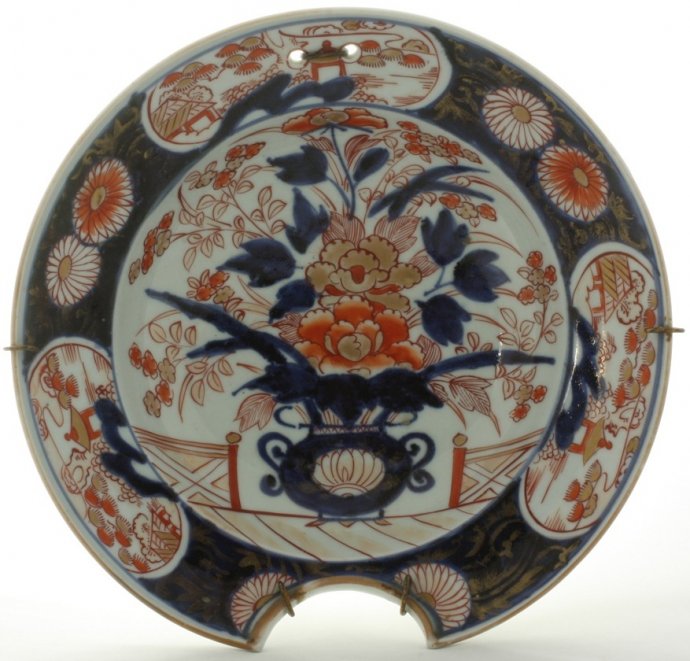
Sold Ceramics - Sold Japanese Imari 1690-1800 - Tableware and other Porcelain with Western Shapes - Page 1
Object 2010141
Shaving bowl
Japan
1700-1730
Height 75 mm (2.95 inch), diameter of rim 275 mm (10.83 inch), diameter of footring 110 mm (4.33 inch)
Shaving bowl on footring, spreading flat, underglaze brown-edged rim (jia mangkou), a saved semicircular section and two small holes on the rim opposite the cut-out section. Imari, decorated in underglaze blue, iron-red and gold with a jardinière on a veranda filled with flowering peonies. On the rim panels filled with a riverscape on an underglaze blue ground with double chrysanthemum flower heads. On the reverse two wide spread flowering prunus sprays.
Shaving bowls were used by barbers and were indispensable in the Dutch household too. They were made of earthenware, pewter, copper and even silver. They had an alternative use, namely to let blood from a vein in the arm during blood-letting, a medical procedure thought to drain bad blood from the system also performed by the barber/surgeon. In the seventeenth century, regulations were put in place in England to govern what barbers were permitted to do. Thus the became confined to bloodletting and treating external diseases. In Prussia the barbers' and the surgeons' guild joined in 1779, and it was said of great Prussian surgeons that they had risen "up from the barber's bowl'. Both purposes explain the semicircular saving. The two holes are for a cord used to suspend it from the client's neck to catch lather and water during shaving, or to hang the bowl on the wall thus implying that owners also appreciated the bowl for its decorative value as well as its function. Chinese shaving bowls usually have the holes in the footring while Japanese examples have them in the rim. (Jörg 2003/1, p.184), (Sargent 2012, p.189)
This shaving bowl was acquired from the son of a barber who lived and worked in Rotterdam, The Netherlands. He told me his father acquired this shaving bowl from Chinese sailor men who paid him with it for his services. His father had this shaving bowl hanging on the wall of his barbershop in the centre of Rotterdam. For some reason he took it home with him on the May 13th, 1940 this was the night before the massive bombing and wipe out of a large part of the Rotterdam's inner city by the German Luftwaffe on May 14th, 1940.
Condition : Perfect.
References:
Price: Sold.
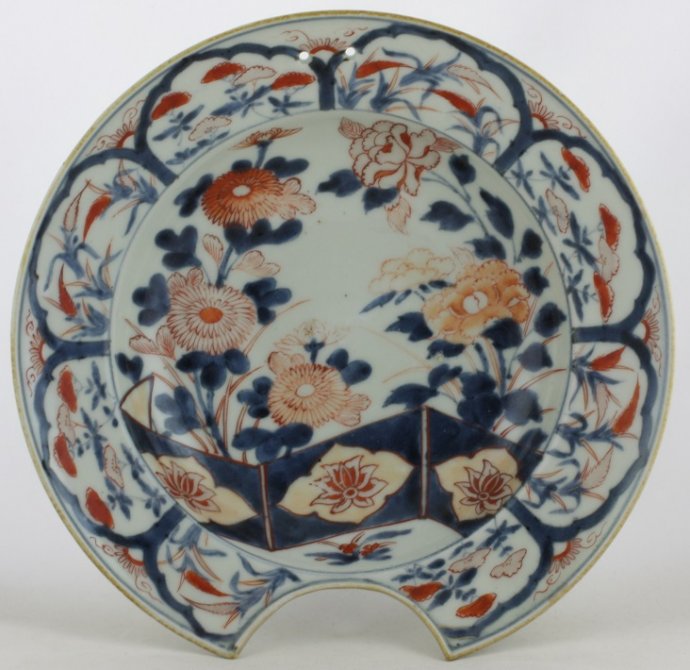
Sold Ceramics - Sold Japanese Imari 1690-1800 - Tableware and other Porcelain with Western Shapes - Page 1
Object 2011817
Shaving bowl
Japan
1700-1730
Height 69 mm (2.71 inch), diameter of rim 275 mm (10.83 inch), diameter of footring 118 mm (4.65 inch), weight 846 grams (29.84 ounce (oz.))
Shaving bowl on footring with a spreading flat rim, in it a saved semi-circular section below and two small glazed holes opposite the cut-out section of the rim. On the base one large spur, its cone still intact. Imari, decorated in underglaze blue, overglaze iron-red and gold in the centre with a fence, behind it a large flowering chrysanthemum (kiku) and peony (momo). On the rim large petal shaped cartouches filled with flowers. On the reverse two wide spread flowering prunus sprays. Three circles around the foot, one on the base.
The first documentary evidence for scheerbeckens or shaving bowls is a 1662 invoice from the Director of the Deshima factory in Nagasaki regarding an order for 258 of these dishes for shipment to the Netherlands. After this point shaving dishes become a regular export item.
Chinese shaving bowls usually have the holes in the footring instead of the rim. Most Japanese barber’s bowls are more or less rounded, whereas Chinese barber’s bowls usually are oval (for a Chinese example, please see the sold archives object 2011301)
Larger pieces of Japanese porcelain such as plates, bowls and dishes, had a tendency to ‘sag’ during firing. That’s why they were often supported in the kiln by small stoneware pillars. After firing, these small cones or spurs which adhered to the base were knocked off, leaving behind small unglazed rough patches or spur marks on the base. The supports were arranged in X, Y or other patterns. Whether they have any relevance to dating or an attribution to a specific kiln is still unresolved. These spur marks are typically Japanese and are rarely seen on Chinese porcelain.
This shaving bowl shows one large spur, instead of several small spur marks, which is unusual. Also, the cone is still intact, which is quite rare (for another such example please see the sold archives object 2011510).
For an almost identically decorated Japanese bowl and cover, please see:
Condition: Some wear to the iron-red decoration due to use.
References:
Arita 2000, p. 91, cat. 282, p. 152, p. 163 & p.233
Jörg 2003/1, p. 14 & pp.184-185
Price: Sold.
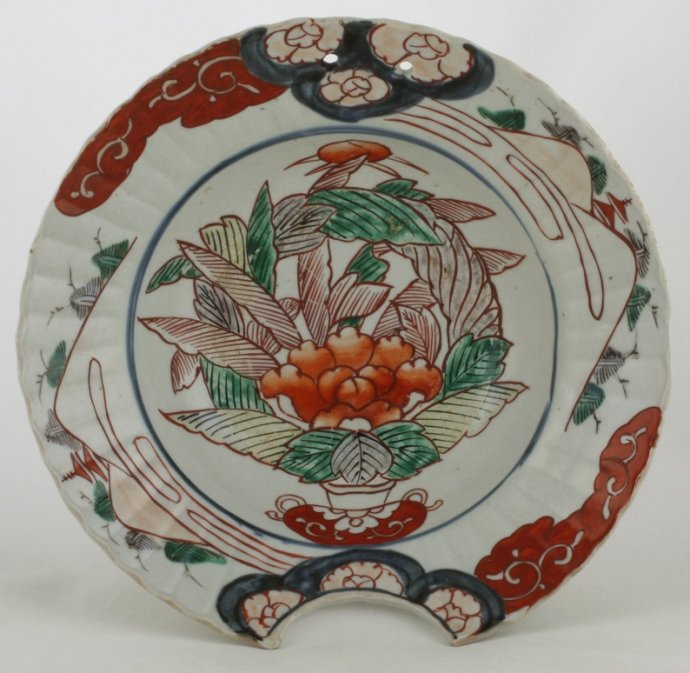
Sold Ceramics - Sold Japanese Imari 1690-1800 - Tableware and other Porcelain with Western Shapes - Page 1
Object 2011818
Shaving bowl
Japan
1700-1730
Height 75 mm (2.95 inch), diameter of rim 248 mm (10.83 inch), diameter of footring 93 mm (4.33 inch), weight 676 grams (23.84 ounce (oz.))
Published: Fraeylema Nieuws, number 52, September 2015
Shaving bowl on high footring. Moulded ribbed rim with a saved semi-circular section and two small holes opposite the cut-out section. Decorated in underglaze blue and overglaze iron-red, black, green, grey and yellow enamel with a jardinière filled with leafy flowering peonies. In the middle in the glaze, a large ring was left unglazed. On the rim a mountainous landscape with trees and a pagoda alternating with three peony flower heads reserved on a underglaze blue ground. On the reverse two wide spread prunus sprays.
Shaving bowls were used by barbers and were indispensable in the Dutch household too. They were made of earthenware, pewter, copper and even silver. They had an alternative use, namely to let blood from a vein in the arm during blood-letting, a medical procedure thought to drain bad blood from the system also performed by the barber/surgeon. In the seventeenth century, regulations were put in place in England to govern what barbers were permitted to do. Thus the became confined to bloodletting and treating external diseases. In Prussia the barbers' and the surgeons' guild joined in 1779, and it was said of great Prussian surgeons that they had risen "up from the barber's bowl'. Both purposes explain the semi-circular saving. The two holes are for a cord used to suspend it from the client's neck to catch lather and water during shaving, or to hang the bowl on the wall thus implying that owners also appreciated the bowl for its decorative value as well as its function. Chinese shaving bowls usually have the holes in the footring while Japanese examples have them in the rim. (Jörg 2003/1, p.184), (Sargent 2012, p.189)
Most shaving basins are decorated in Imari, but this example was made in one of the smaller kilns which used a different technique, in which the objects were stacked on to each other in the oven while in the middle of the shaving basin, in the glaze, a large ring was left unglazed in order to prevent that the objects would stick to each other during the firing process. That ring is sometimes quite visible, on this object it is subtly hidden in the decoration in enamel colors. (source: Fraeylema Nieuws, number 52, September 2015)
For an identically sized and shaped shaving bowls, please see:
- Oosterse keramiek uit Groninger kollekties,exhibition catalogue Groninger Museum, (C.J.A. Jörg, Martinipers/Wolters-Noordhoff, Groningen 1982). p.81, cat. 123.
- Fine & Curious, Japanese export porcelain in Dutch Collections, (C.J.A. Jörg, Hotei Publishing, Amsterdam, 2003), p.185, cat. 229.
Condition: Two chips to the rim.
References:
Fraeylema Nieuws, number 52, September 2015
Price: Sold.
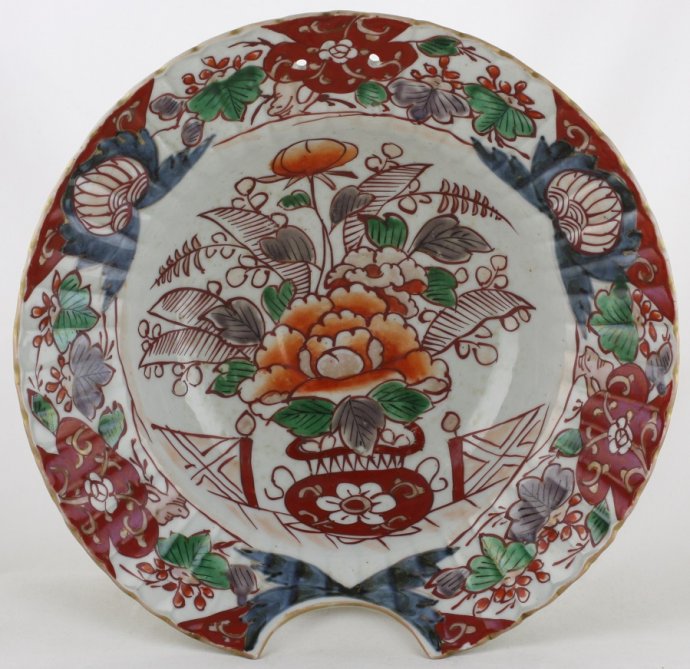
Sold Ceramics - Sold Japanese Imari 1690-1800 - Tableware and other Porcelain with Western Shapes - Page 1
Object 2012369
Shaving bowl
Japan
1700-1730
Height 83 mm (3.27 inch), diameter of rim 242 mm (9.53 inch), diameter of footring 93 mm (3.66 inch), weight 724 grams (25.54 ounce (oz.))
Shaving bowl on high footring. Moulded ribbed rim with a saved semi-circular section and two small holes opposite the cut-out section. Decorated in underglaze blue and overglaze iron-red, black, green enamel and gold with a jardinière on a fenced terrace filled with leafy flowering peonies. On the rim a flowering tree with leafy branches growing behind a reserve a shaped reserve filled with a flower head and leafy branches in reverse decoration alternating with flower heads on an underglaze blue ground. On the reverse two wide spread prunus sprays.
The first documentary evidence for scheerbeckens or shaving bowls is a 1662 invoice from the Director of the Deshima factory in Nagasaki regarding an order for 258 of these dishes for shipment to the Netherlands. After this point shaving dishes become a regular export item.
Chinese shaving bowls usually have the holes in the footring instead of the rim. Most Japanese barber’s bowls are more or less rounded, whereas Chinese barber’s bowls usually are oval (for a Chinese example, please see the sold archives object 2011301)
For identically shaped and sized and similarly decorated shaving bowls, please see:
- Oosterse keramiek uit Groninger kollekties,exhibition catalogue Groninger Museum, (C.J.A. Jörg, Martinipers/Wolters-Noordhoff, Groningen 1982). p.81, cat. 123.
- Fine & Curious, Japanese export porcelain in Dutch Collections, (C.J.A. Jörg, Hotei Publishing, Amsterdam, 2003), p.185, cat. 229.
Condition: A frit to the rim.
References:
Price: Sold.


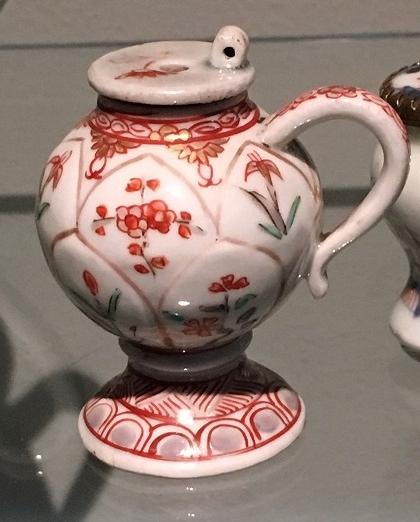
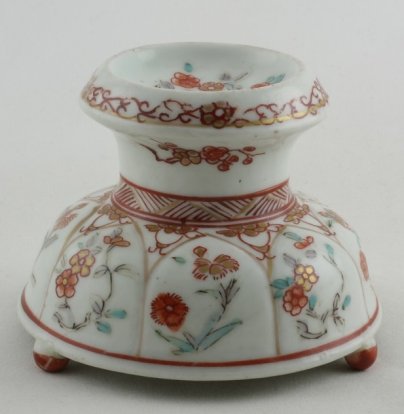
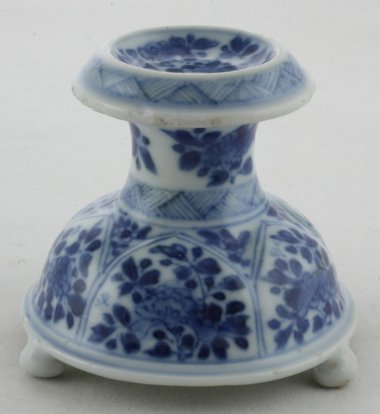

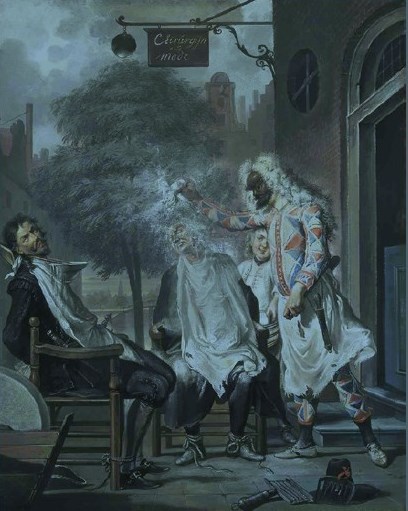
 create websites
create websites